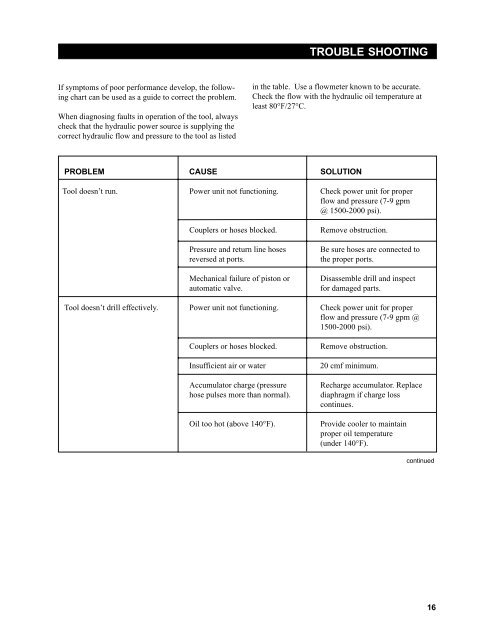Hydraulic Sinker Drill - Tool-Smith
Hydraulic Sinker Drill - Tool-Smith Hydraulic Sinker Drill - Tool-Smith
If symptoms of poor performance develop, the following chart can be used as a guide to correct the problem. When diagnosing faults in operation of the tool, always check that the hydraulic power source is supplying the correct hydraulic flow and pressure to the tool as listed in the table. Use a flowmeter known to be accurate. Check the flow with the hydraulic oil temperature at least 80°F/27°C. PROBLEM CAUSE SOLUTION TROUBLE SHOOTING Tool doesn’t run. Power unit not functioning. Check power unit for proper flow and pressure (7-9 gpm @ 1500-2000 psi). Couplers or hoses blocked. Remove obstruction. Pressure and return line hoses Be sure hoses are connected to reversed at ports. the proper ports. Mechanical failure of piston or Disassemble drill and inspect automatic valve. for damaged parts. Tool doesn’t drill effectively. Power unit not functioning. Check power unit for proper flow and pressure (7-9 gpm @ 1500-2000 psi). Couplers or hoses blocked. Remove obstruction. Insufficient air or water 20 cmf minimum. Accumulator charge (pressure Recharge accumulator. Replace hose pulses more than normal). diaphragm if charge loss continues. Oil too hot (above 140°F). Provide cooler to maintain proper oil temperature (under 140°F). continued 16
17 PROBLEM CAUSE SOLUTION Tool operates slow Low gpm supply from power unit. Check power unit for proper flow (7-9 gpm) High backpressure. Check hydraulic system for excessive backpressure (over 250 psi). Couplers or hoses blocked. Remove obstruction. Orifice plug blocked. Remove restriction. Oil too hot (above 140°F) Check power unit for proper oil or cold (below 60°). temperature. Bypass cooler to warm oil up, or provide cooler to maintain proper temperature. Relief valve set too low. Adjust relief valve to 2100-2250 psi. Tool gets hot. Hot oil going through tool. Check power unit. Be sure flow rate is not too high causing part of the oil to go through the relief valve. Provide cooler to maintain proper oil temperature (under 140°F). Check relief valve setting. Oil leakage on drill steel. Lower piston or drive hex Replace seals. seal failure. Oil leakage through charge Upper piston seal failure or Replace seals, recharge or valve cap. accumulator or o-ring failure replace accumulator or accumulator charge loss diaphragm. or failure. Oil leakage around trigger. Valve spool seal failure. Replace seals. Low rotation torque. Motor not completely broken in. Continue operation to break in motor. Excessive oil temperature Provide cooler to maintain oil causes operating pressure loss. temperature (under 140°F). Damage to motor clearances. Repair as required. Insufficient air or water. 20 CFM minimum. Mechanical binding during drilling. Take care to guide drill straight.
- Page 1 and 2: SERIOUS INJURY OR DEATH COULD RESUL
- Page 3 and 4: 1 Accessories .....................
- Page 5 and 6: 3 Always replace parts with replace
- Page 7 and 8: HOSE HOSE TYPES TYPES Hydraulic hos
- Page 9 and 10: PREOPERATION PROCEDURES Preparation
- Page 11 and 12: Good maintenance practices will kee
- Page 13 and 14: ushing bores are yellow-bronze, rep
- Page 15 and 16: 13 accumulator. If the washer is no
- Page 17: CHARGING THE ACCUMULATOR To check o
- Page 21 and 22: Item No Part No Qty Description 1 0
- Page 23 and 24: 21 WARRANTY Stanley Hydraulic Tools
If symptoms of poor performance develop, the following<br />
chart can be used as a guide to correct the problem.<br />
When diagnosing faults in operation of the tool, always<br />
check that the hydraulic power source is supplying the<br />
correct hydraulic flow and pressure to the tool as listed<br />
in the table. Use a flowmeter known to be accurate.<br />
Check the flow with the hydraulic oil temperature at<br />
least 80°F/27°C.<br />
PROBLEM CAUSE SOLUTION<br />
TROUBLE SHOOTING<br />
<strong>Tool</strong> doesn’t run. Power unit not functioning. Check power unit for proper<br />
flow and pressure (7-9 gpm<br />
@ 1500-2000 psi).<br />
Couplers or hoses blocked. Remove obstruction.<br />
Pressure and return line hoses Be sure hoses are connected to<br />
reversed at ports. the proper ports.<br />
Mechanical failure of piston or Disassemble drill and inspect<br />
automatic valve. for damaged parts.<br />
<strong>Tool</strong> doesn’t drill effectively. Power unit not functioning. Check power unit for proper<br />
flow and pressure (7-9 gpm @<br />
1500-2000 psi).<br />
Couplers or hoses blocked. Remove obstruction.<br />
Insufficient air or water 20 cmf minimum.<br />
Accumulator charge (pressure Recharge accumulator. Replace<br />
hose pulses more than normal). diaphragm if charge loss<br />
continues.<br />
Oil too hot (above 140°F). Provide cooler to maintain<br />
proper oil temperature<br />
(under 140°F).<br />
continued<br />
16



